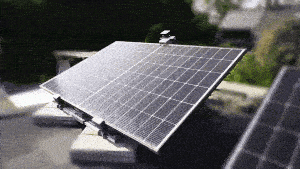Ok, I’m just testing with your template and no equipment connected. I have copied your template. So i cant understand why i have 0% on all negative angles
I’ll leave it running for a few days to get a better understanding of the figures i think
Because if you look at the pictures of the original post you will see the panel can only go flat or it can go up. So the minimum tilt angle is something like 0 degrees. So 0 degrees is 0%, -10 degrees, -20, -30 are also 0% etc. It makes sense ![]()
Hi Guys,
I do not really have a question just wanted to share what I made (and return what I learned also based on the information here).
The last year I was working on the “Sunchronizer S1”. A single axis solar tracker that can be used with “standard” 400W solar modules. The custom parts can be 3D printed.
Long story short: I documented the project at the following locations:
- Hackaday .io: Sunchronizer S1 - Elevation Axis Solar Tracker | Hackaday.io (Here you can also find the link to the ESPHome config)
- Nerdiy .de (my blog): Sunchronizer S1 - 400W solar tracker for elevation axis
The ESPhome configuration is WIP but works already pretty good for the single axis version. I plan to extend the single axis version to a dual axis tracker, therefore there are already some codesnippets prepared in the ESPHome-config. Maybe you can use some of the things. ![]()
If you need anything, just let me know. ![]()
Best regards
Fab

Great project. If I understand correctly you are tracking the sun with lux sensors rather than using the mathematical tracking I used here right?
Thanks. ![]() Yes and no.
Yes and no. ![]()
Currently the sun tracking is based on the mathematics based on the sun azimuth and elevation angle (and time of course).
(For that purpose I also integrated a GPS receiver to get time and position independently from network access. But thats another story…)
The Lux sensor actually escalated a bit to a project in a project. I started to design a solar tracking sensor called “SolSpot” (More info here: SolSpot - A universal light sensor for solar tracker setups | Details | Hackaday.io) for two reasons. One was that the direct tracking would be “better” than the calculated tracking (which is of course wrong, especially when you consider the additional amount of work/material). The other one is that I would also try to cover the low light cases when the sky is cloudy. Based on my tests/experience its best to put the panel as flat as possible.
Next step is to develop an algorithm that uses the data from the lux sensors and from the GPS sensor to calculate the best angle possible.
So the whole sensor situation is still under test and I want to check whats working best/most reliable. ![]()
If you have any ideas or feedback let me know. ![]()